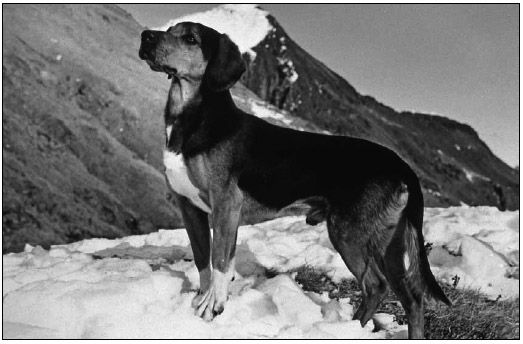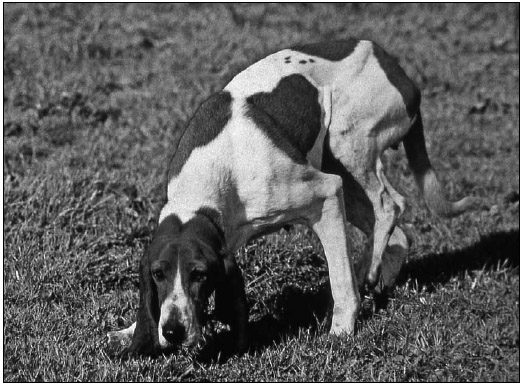Nose deep on the track or up in the wind
Nose deep on the track or up in the wind
Four-legged hunters – with and without noises
by Heini Hofmann
Among all livestock, the dog is man’s most versatile helper. However, the most natural teamwork in such partnerships between two- and four-legged friends has developed between the hunter and the hound, even more so than with farm- and shepherd-dogs.
Whereas protection dogs, disaster dogs and avalanche dogs were educated for civilising activities, hounds follow their original instincts at work, the predatory and pack instinct – in technical language: angewölft (wolven=wölfisch). But hounds are not alike, neither in terms of race nor the intended type of use. As varying as the external appearance, as versatile are the tasks of the four-legged hunting partners in the service of the huntsmen.

The chiming of the pack
That the hound as a primeval helper of man is not an ordinary dog, is already expressed in the huntsman’s way of speaking [for most of the following special hunting-expressions we could not find an English translation]: his body structure is called ‘Gebäude’, his coat is the ‘Decke’, the legs are the ‘Läufe’, and the claws are the hooves. His mouth is called muzzle, the ears are called ‘Behang’, the lips are called chaps and the nose is called ‘Windfang’. And if one speaks of the chiming of the pack, then the lasting ‘Spurlaut’ is meant; for a hound does not just bark, he gives tongue, gives mouth or ‘gives neck’. And he peers – or looks intently the game.
The tail is the ‘Rute’ and if it wears a curtain of hair, this is the ‘flag’. ‘Weidloch’ stands for anus, entrails for bowels. The ‘Geschröt’ is the testicles and the ‘Feuchtglied’ the penis, while ‘buckle’ (Schnalle) names the vagina. The verb to buckle, however, has nothing to do with copulating, but means to let the dog from the leash, unlike to take which means to leash. The art of hunting-vocabulary has its own laws.
The bleeding from the vagina of the hot bitch is called dyeing, while urinating means watering. In the process of bearing the dropping becomes ‘Wölfen’ – in reversion to the ancestor of all wolves. If a hound is fully qualified, he is walked off or firm. Then he is well trained and very obedient. Such skilled dogs are praised by the hunter verbally and with strokes, and this is called ‘abliebeln’ – a term of this almost cultic human-animal relationship.
Performance before beauty
The genesis of the hounds during the process of domestication was characterized by the different regional and epochal hunting methods and the hunted game. Depending on the type of use, selections are made from existing types by crossing and selection on suitability and expected performance. However, the actual breeds developed only from the 19th century onwards with the beginning of organized dog breeding. Even in today‘s hound breeding, performance prevails over beauty, which is not only conducive to fitness but also protects against unbiological breeding currents. The legislator has even a heart for hybrids. They can also be permitted to hunt.
While the ancient hunter used the loudly hunting Braque and the silent sighthound working on demand, the medieval hunt on horse asked for the pack dog and lead dog. The huntsmen found the Pointer through fowling, while the water game hunt needed the retrievers. Only great dane-like dogs were able to cope with defensive game-like bear and wild boar were, whereas the short-legged, Dachshund running after predator game was qualified for the fox hunt. The emergence of firearms ultimately led from the lead dog to the Limer.

Hounding and Bushland hunting
The current classification of hunting dogs lists hounds, which is the oldest breed of hunting dogs and breeding stock for many other races including all hunting dog races of Helvetian origin (see box), other groups are the bloodhounds (such as Hanoverans or Bavarian mountain bloodhound), forager dogs (for instance spaniels), pointers (such as setters, German shorthaired and wirehaired, little Munsterlander), terriers and dachshunds as well as retrievers (for instance Labrador retrievers).
The possible hunting activities performed with dogs are as varied as the list of races: Hounding means that the dogs hunt independently either alone or in the pack, startling foxes and hares without sight connection to the hunter who tracks the hunt lead by the bellowing sound.
In the quiet hunt in bushland the dog searches “under the shotgun” (scattershot distance 20–35 meters), always stays in sight contact with the master by whom he is directed with sound or visual signs. Foraging is the tactics of choice to hunt small game, especially waterfowl in thicket or reed. Since sight contact is not possible here, the dog hunts and gives bellowing signals to announce whether he has found wild game, how the hunting unfolds, and – depending on the kind of his bellowing sound – which kind of game he found.
Pointing and Retrieving
In open land, searching and pointing are required. The pointer searches with his nose up in the wind, he remains in contact with the hunter and is directed by him. When the dog has found wild game, he approaches it carefully while staying quiet and “points” to it, standing still at the site thereby indicating to the hunter that he was successful.
Belowground hunting in the often quite spacious fox dens is necessarily an independent activity for short-legged dogs who give bellowing signals but are otherwise without contact to the hunter. The aim is to drive reynard out of his hole. Other dogs are specialized in retrieving and know how to secure small game at land or in water.
One of the most challenging jobs for hunting dogs is to follow wounded game, i.e. persistence hunting at the red track, for which suited individuals of several races may be employed. While keeping such a track the dog remains connected with the master via a long lace. As soon as the last, still warm resting ground of the wounded game has been found the dog may work alone. If he finds the animal already dead he will announce that. Is the game still mobile he will confront it and announce the position to the hunter so that he can redeem it as soon as possible.
Still natural

Since they are still allowed to live their lives according to their natural instincts to a large extent, hunting dogs belong to those domestic animals with the closest links to their true nature – this is an aspect which is often overlooked. But because their tasks are so challenging in every specialization a serious training for at least two years is required in order to develop the playful pup into a firm working dog; the genome will only partially provide for the success.
And just like every good hunter the fully trained hunting dog needs continuous upgrade training. His work is also subject to legal proceedings, cantonal laws may differ in some aspects. For-instance, some cantons still ban hounding dogs which is due to the outdated and erroneous assumption that they were responsible for a decline in the number of roe deer.
Invention of the gods
“Hunt without hound is not sound up to much” an old German proverb states which is obviously inappropriate in this absoluteness. It does, however, make sense if changed to “hunt with the wrong dog” – especially regarding keeping red tracks of wounded animals. Because an ill-trained track-keeper would make a wounded wild game or an animal hit in a road traffic accident – which has become the most likely reason to perform this task – suffer longer.
Not all hunters work together with the “sixth sense”, the dog. But those huntsmen who do perform their art of hunting in partnership with the oldest helpmate of man are convinced, that it is this very interplay of intelligence and instinct which turns the hunt into this integral experience and they feel endorsed by Greek writer Xenophon, who praised hunting and dogs as inventions of the gods. •
(Translation Current Concerns)
Two Swiss quartettes
HH. In the wide range of European hunting dog breeds there is also a proud contribution from our country, namely the Swiss scent hound and the Swiss hounds that belong to the Braques. They are the third group of Swiss dog breeds in addition to the Swiss mountain dogs and Saint Bernhard dogs. In contrast to sighthounds and greyhounds that hunt for sight with their noses up in the wind, the “scent hounds” and “Swiss hounds” have their noses deep on the track. Untiring, with unerring instinct and loud crying, they track their quarry.
The quartette of short- or stick-haired Swiss scent hounds impresses with a slim, elongated body with long legs and includes the following colours: Schwyz hound (red spotted), Bernese hound (three coloured, white-black-brown), Lucerne hound (dappled blue with yellow-brown markings) and Bruno Jura hound (black-brown). Their short-legged spitting image with the same colour and analogous designation, the Swiss hounds are also vivacious strollers with a big hunting passion.
(Translation Current Concerns)